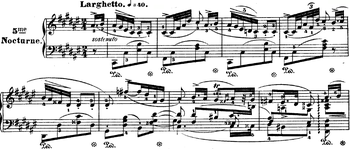Nocturnes, Op. 15 (Chopin)
The Nocturnes, Op. 15 are a set of three nocturnes written by Frédéric Chopin between 1830 and 1833. The work was published in January 1834, and was dedicated to Ferdinand Hiller.[1]

Nocturne in F major, Op. 15, No. 1
Chopin's fourth nocturne, it was composed in 1832 in simple ternary form (A-B-A). The first section in F major is marked Andante cantabile while the second section in F minor is fast and dramatic (Con fuoco).

Nocturne in F-sharp major, Op. 15, No. 2

Composed in 1832, it is a technically challenging piece in A-B-A form, in 2/4. The first section, Larghetto (mm.40), features an intricate, elaborately ornamental melody over an even quaver bass. The second section, labelled doppio movimento (double speed), resembles a scherzo with dotted quaver-semi quaver melody, semiquavers in a lower voice in the right hand, and large jumps in the bass. The final section is a shortened version of the first (14 bars rather than 24) with characteristic cadenzas and elaboration, finishing with an arpeggio on F♯ major, falling at first, then dying away.

Nocturne in G minor, Op. 15, No. 3

Chopin's sixth nocturne begins with a slow lento tempo and is written in 3/4 time. The right hand part is composed of simple eighth and quarter note patterns, followed by a chromatic rise and fall. The left hand part maintains quarter note patterns to support the right hand, with pedal marks every six notes. The ending part of the piece is marked religioso and uses legato chords in the right hand part. The piece also has extreme dynamic contrasts, ranging from fortissimo to pianissimo (see Dynamics).
The piece departs from the usual ternary form in a Chopin nocturne. The concluding section is not only unrelated thematically to the opening one but in a different key (F major). The last four bars return to G minor, though the final chord is major (a Picardy third), as is usual in a Chopin nocturne.
Chopin originally entitled this nocturne "At the cemetery" when he composed it a day after he attended a performance of Hamlet, but erased the inscription when the piece was to be printed, saying: "Let them work it out for themselves."[2][3]
References
- Niecks, Frederick (1890). Frederick Chopin, as a man and musician, Volume 1. Novello and company, limited. p. 268.
- Chopin: Work list - ourchopin.com
- M. A. Szulc, Echo Muzyczne, 1880
External links
- Nocturnes Op.15: Scores at the International Music Score Library Project (IMSLP)
- Nocturne No. 3 in G Minor sheet music available at Musopen.com